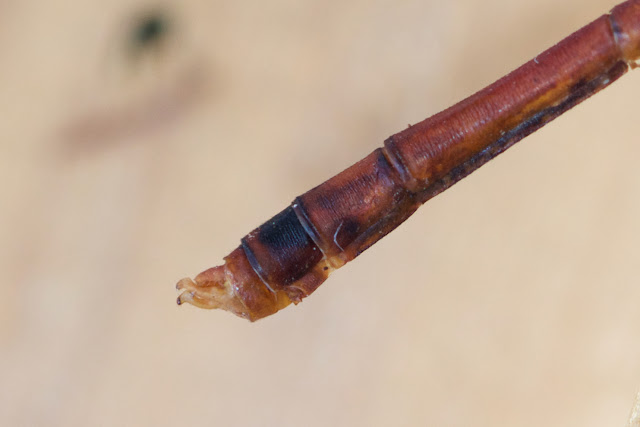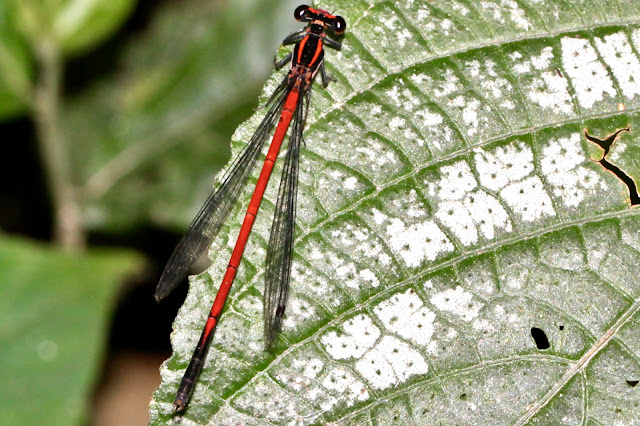Family Platycnemididae
Calicnemia doonensis carminea
Lieftnick 1984
Elevation 500-1700
Abdomen length 33-34mm
The inferior anal appendages are longer than the superior. Older males tend to darken on the lateral thorax to a dark purplish-blue. Usually, a good number are present when found, which is usually a very small running stream with some seepage with lots of side vegetation. There are four known locations, Pokhara, mill stream on Daman Hwy, Tansen, and several roadside areas above Hetauda, at elevations between 900m and 1500m on perennial streams and seepages. It was mating in July with plenty of males and females present. One male was found in May with very light colors.
Male


Female
Calicnemia eximia
(Selys 1863)
Elevation 300 -2100m
Abdomen Length 30-34mm
They resemble other red Calicnemia sp. at first but when the small dot of yellow is seen on the humeral area of the thorax it is certain to be C. eximia. Males and females are similar except in coloration. They are usually found next to seepages similar to Drepanosticta locations and often in the same place. This one was near Mardi Khola on a rock wall next to a small stream. They are found from May through August and across the Himalayan region.
Male
Male
Female
Calicnemia miniata
(Selys 1886)
Elevation 800 to 1600m
Abdomen Length 30-32mm
This is a species from Ilam in east Nepal. The male is characterized by the bright red stripes on its black thorax with narrow yellow stripes laterally. The abdomen is bright red to the basal 1/3 of segment 7 the rest black including the anal appendages. The female is a yellow and orange version of the male. They are not as common in Nepal as other Calicnemia relatives. These were photographed in May before the monsoon.
Male
Female
Calicnemia nipalica
Kimmins, 1958
Elevation 800 to 1600m
Abdomen Length 31mm
This is an uncommon wetland inhabitant in Nepal and listed as vulnerable by IUCN. It rests along the seepages and small canals in darker areas of the jungle and might be easily overlooked. The color of the adult takes time to deepen. From its emergence, in mid-April, the male and females have similar colorations but by June the male's color deepens to a darker red and solid black toward the end of the abdomen. Mating observed in late June and it is present through July.
Male
Female
Calicnemia pulverulans
(Selys, 1886)
Elevation 800 to 2000m
Abdomen length 29-31mm
C. pulverulans lives in the same dark forested conditions as C. nipalica - they are often found nearby. The abdomen color is powdery blue as they pruinose early in life, overall it has a waxy blue color with some yellow to pale blue lateral thoracic stripes. A Himalayan native seen from NW India to NE India and into Myanmar. They are mostly found May through July mating in early May.
Male


















No comments:
Post a Comment